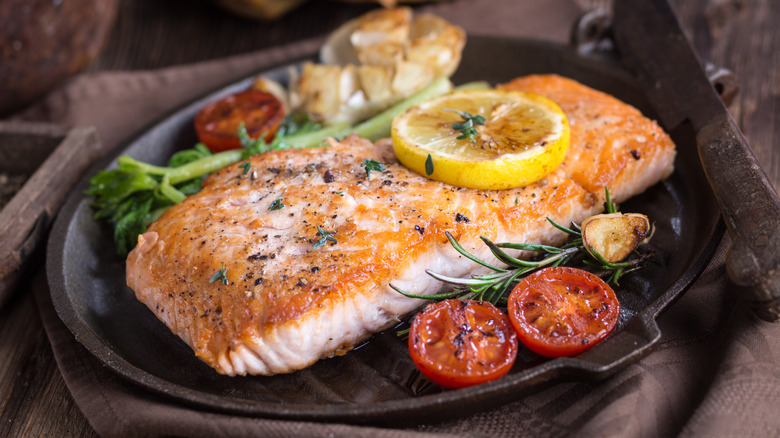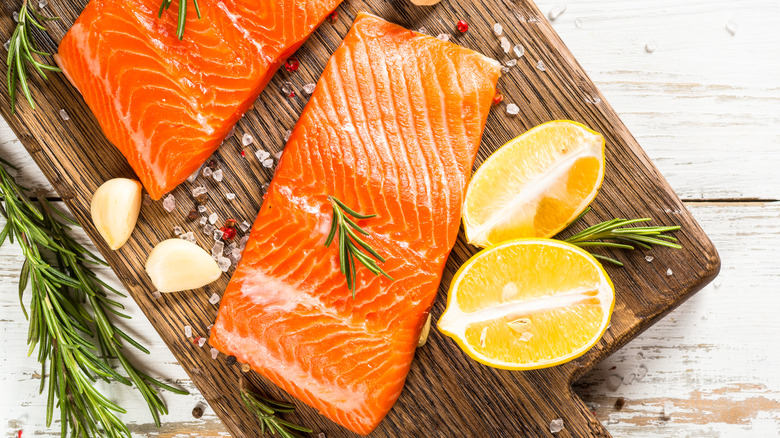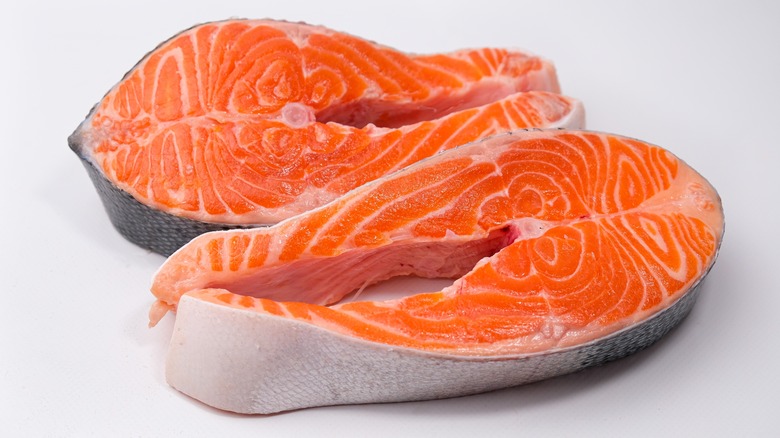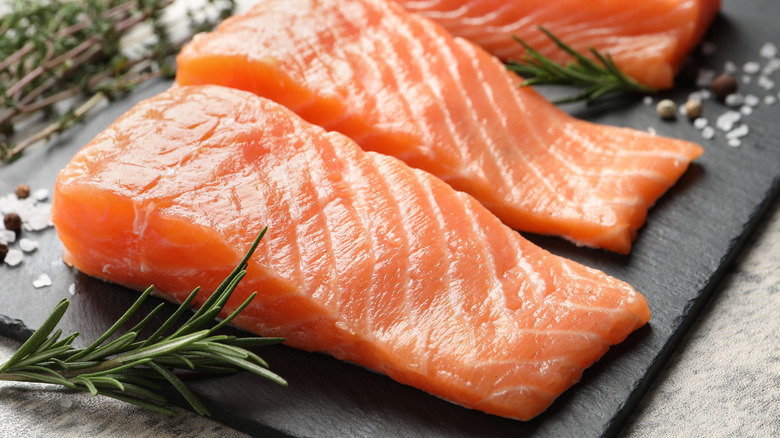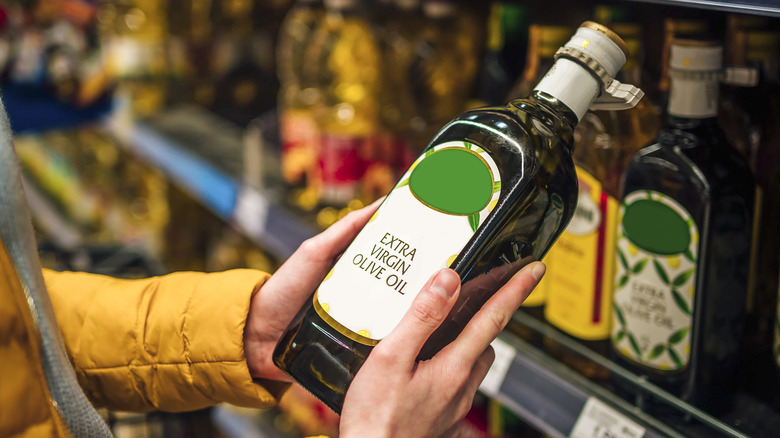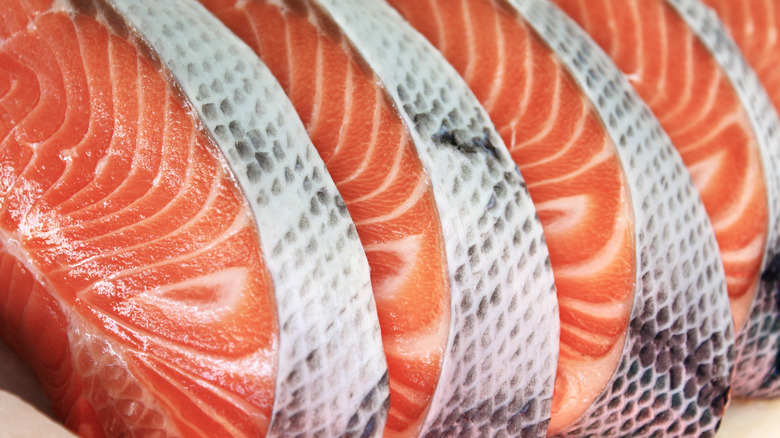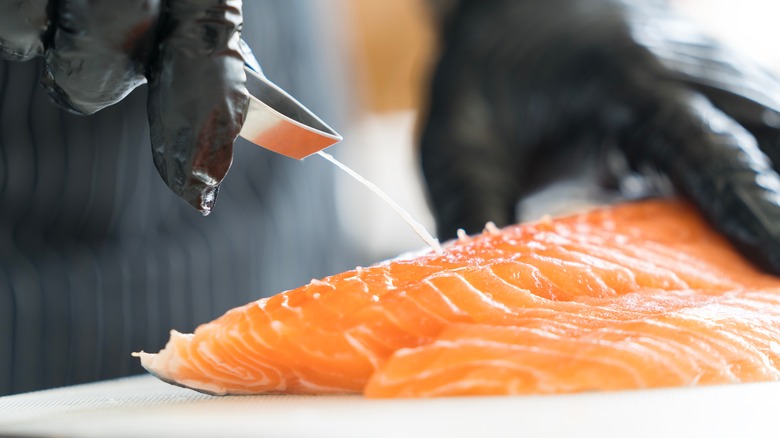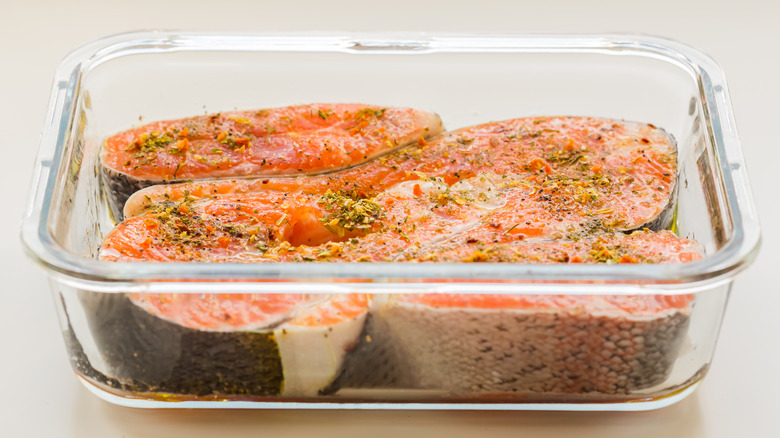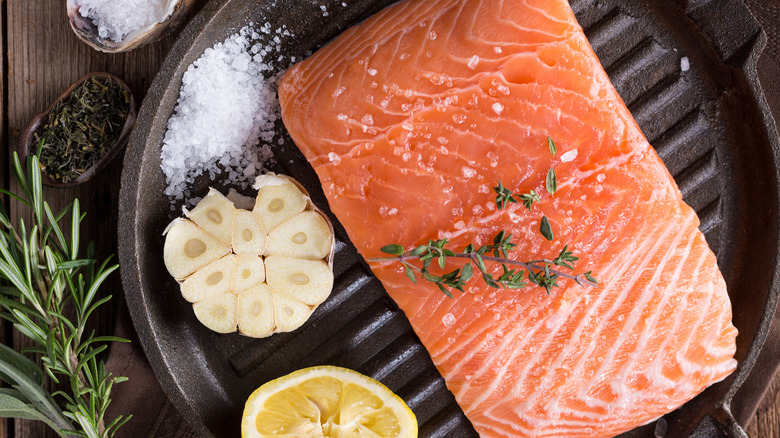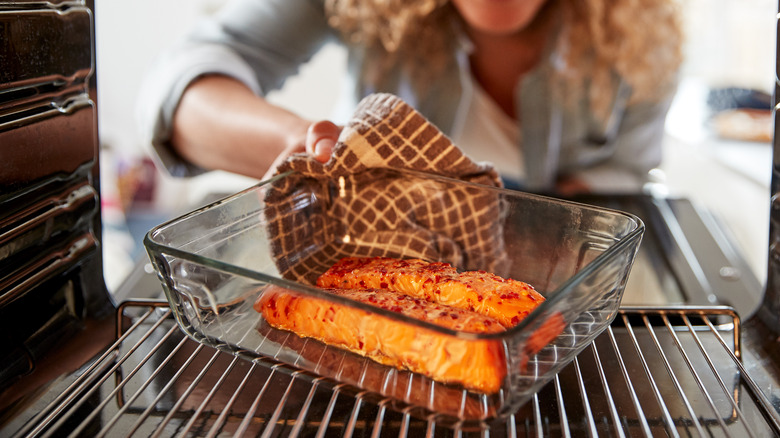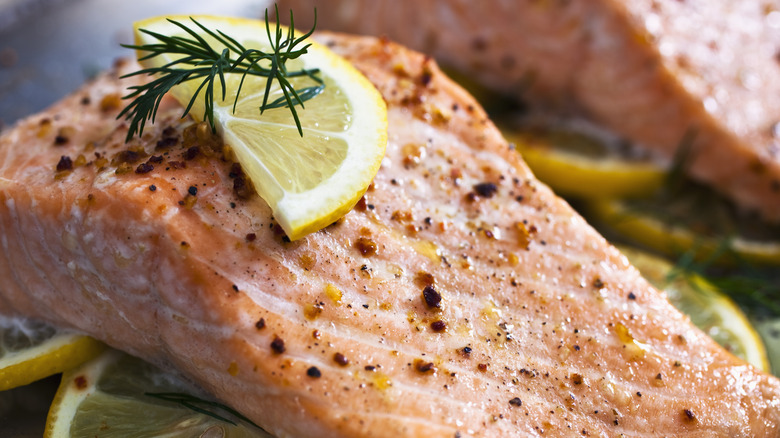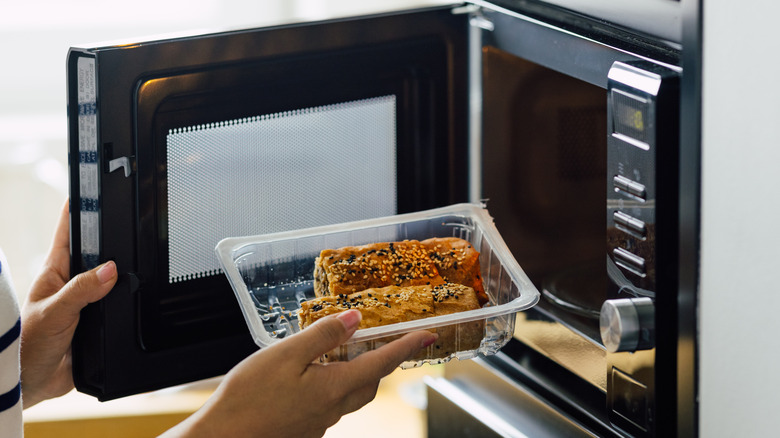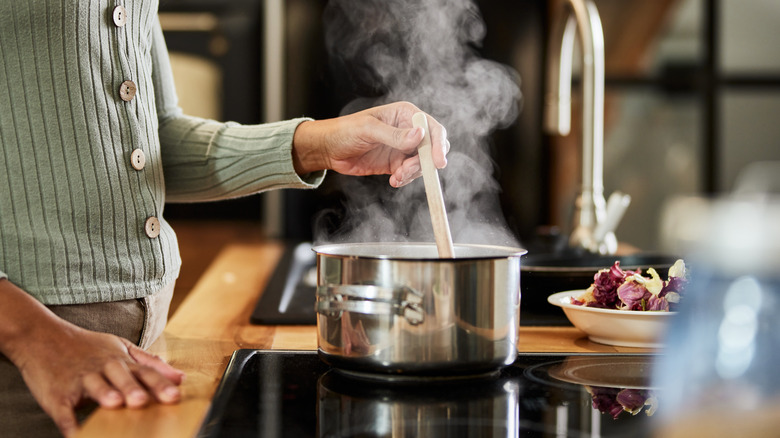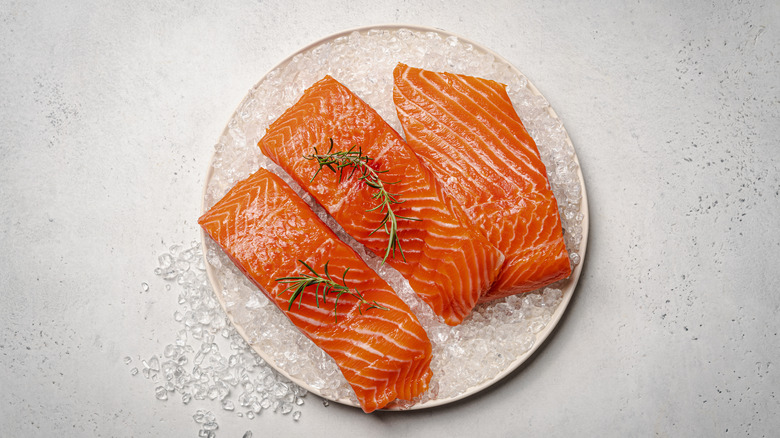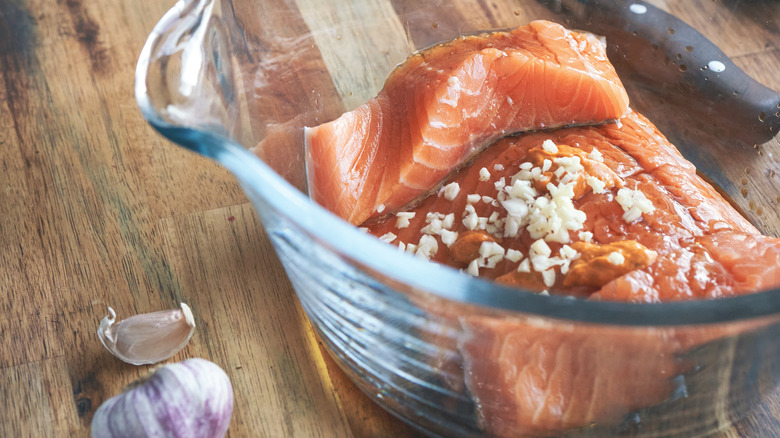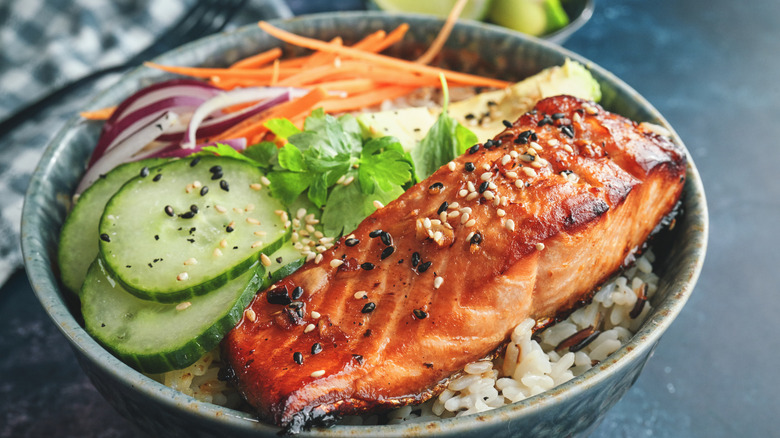Avoid Making These 14 Mistakes When Cooking Salmon
We may receive a commission on purchases made from links.
Salmon is simultaneously delicious and intimidating. When you nail it, it's an impressive dish to serve: tender, flaky, mildly briny, rich, and even a bit sweet. On the flip side, it's a real bummer when you get salmon wrong, especially given how expensive it is these days.
The unfortunate truth is that salmon just isn't an easy fish to make correctly. I've spent a lifetime trying different ways to prepare it, from homemade lox and salmon candy to canned salmon for salads. I've made plenty of plain, workaday baked and broiled salmon along the way — I've peppered it, steamed it, poached it, put it in ceviche and sushi, you name it. In that time, a lot has gone wrong — but a lot has gone right, too.
If my experience is anything to go by, you're not destined for eternal salmon failure. Between pan-searing and roasting, grilling and smoking, poaching and steaming, there are some basics to follow that will help you achieve the correct level of doneness and the right flavor every time. Check out the following salmon mistakes and how to correct them.
1. Buying cheap cuts of salmon
The first and worst mistake you can make when buying salmon is to take the low road at the grocery store. At most larger stores, you'll see a large display of salmon represented by different species, places of origin, catching methods, and levels of sustainability. You can also choose between wild and farmed, and if there's a selection, there's likely to be a sale or two, as well.
Take heart — all you need to make this important choice is a little education (like this ultimate guide to buying salmon at the grocery store). Specifically, make sure you match your recipe to your cut, as fillet and steak recipes aren't easy to translate. You should also check if your recipe specifies wild versus farmed salmon, as the latter is fattier than the former. While this makes the farmed variety richer and more buttery, which some people enjoy (including yours truly), you may need to adjust cooking times, oil amounts, and flavoring accordingly.
In general, you want fish that's glistening and untorn, with no signs of graying or dullness. Opt for salmon that was flash-frozen at sea where possible. Even better, get fish that was never frozen — but don't use it for sushi, as it might contain parasites that flash-freezing eliminates.
2. Failing to wash and dry fishy-smelling salmon
While plenty of people will tell you to avoid washing raw fish before cooking due to the danger of spreading bacteria, the research backing this is based on poultry, which, when raw, is more likely to get you sick than fish. Indeed, a 2013 CDC study reported that 46% of hospitalizations for food-borne illness were from land animals, compared to only 6% from seafood.
That said, sometimes you do need to wash salmon, like if it smells fishy or feels slimy. A clean surface will also allow your recipe's fat (such as butter or oil) to contact the fish directly, which ensures the best chance of even cooking. Any lingering liquid can block your oil or butter from contacting the flesh and skin, which will reduce crispiness. For clean salmon, simply hand-wash it in the sink with cold water, then pat it dry with rags or paper towels.
Take care, however, if you do decide to wash your salmon. Put it in the bottom of the sink and use low water pressure to avoid splashing. Wash it quickly, and don't shake it. Move it straight over to the towels to dry, then wash your sink and backsplash.
3. Salting at the wrong time
Yes, you should salt your fish. No, you shouldn't salt it 30 minutes before cooking and then leave it lying on the counter. This will draw moisture out of the fish and make it soggy prior to cooking, so remember to salt your salmon right before it goes into the pan or oven.
The exception is if you plan to dry-brine your fish, which is one of the best methods for making it ultra-crisp and tasty. This will break down the albumin, the clear stuff that egg whites are made of that turns into white albumin ooze when cooked. Dry-brining involves rubbing your fish all over with salt and then letting it sit overnight; just before cooking, wipe or rinse the salt off.
You can also use an actual brining liquid made of 1 tablespoon of salt dissolved in 2 cups of hot water, which should then be cooled before you add about 1¼ pounds of fish. Let it sit for about half an hour, remove and drain it (or pat it dry), and bake. If you don't want to bother with brining at all, salt your fish generously right before you stick it in the oven and call it good.
4. Cheaping out on ingredients
No home cook is free from the temptation to cut costs; salmon, however, deserves the best. Depending on the cut, species, and purveyor, you'll likely pay $15 to $30 per pound at the store, so it's worth spending a bit more on your other ingredients to make the dish worth it. These include nice olive oil, lemons, and grill planks, among others.
Grill planks are especially useful as a means of fixing fishy salmon, and they're quite affordable. You can get a 12-pack on Amazon for less than $20, and you can usually find them at bigger grocery stores, as well. If you're using lemons, opt for ones that are firm, bright, and organic. Yes, organic matters here — 2022 research published in the journal Agronomy has shown that conventional lemons have a less distinct flavor and aroma. (Also, make sure to choose traditional lemons, as Meyers are sweeter and more mild.) As for olive oil, look for a nice, middle-of-the-road bottle. If you're uncertain about how to do so, try some of the best olive oil brands available in stores.
5. Removing the skin
The mistake everyone makes with salmon skin? Taking it off. Salmon skin contains tons of flavor, helps fish heat evenly due to its fat content, and locks in moisture with a lipid barrier. It also releases fat while cooking, helping coat the pan and (if you flip your salmon) the second side. Even if you don't want to eat it after cooking, you should leave it on during the process, whether you're baking, broiling, pan-frying, or grilling.
If you're going to poach your fish, however, removing the skin is a must. If you don't, your poaching liquid will get oily and may have scales floating in it. If you're going to poach, use a fillet knife to remove the skin, ensuring you cut off all of that gray intermediate layer between the pink flesh and the skin.
But hold off on composting the skin just yet: You can still cook it on its own in the oven. Cut your skin into 1-inch strips, season it with a little olive or sesame oil, and put a dash of soy sauce or coconut aminos on the top. Then, pop it into a preheated, 450-degree Fahrenheit oven, cook it for 8 to 10 minutes (or until the skins crisp up), and snack away.
6. Forgetting to remove the bones
Pin bones are annoying to remove, but they're even more annoying to pick out of your fish one mouthful at a time. In fact, they're not even bones, which is why they're so often left behind, even by reputable seafood purveyors. They're actually calcified ligaments — but that doesn't make them edible.
Always check your salmon for bones by running your hands over the top of the fish and pressing lightly (very lightly, as you don't want salmon to bruise before cooking). When you find a bone, you can pull it out with your fingernails or, if that doesn't work, with needle-nose pliers. Note that you never need to dig bones out of a fillet; you just need to locate the head of the bone, grab it, and tug gently. It should slide out right away as soon as you get past the top section. This works for steaks as well as fillets (and all types of fish, not just salmon).
7. Choosing the wrong vessel for the job
A well-seasoned cast iron pan is the best vessel for salmon, as it's naturally nonstick and will release the fish with no tearing (like in this herby lemon butter fish skillet recipe). Although most people associate cast iron pans with the stovetop (and they're certainly excellent for this purpose), you can stick them in the oven, too. In fact, this is an excellent way to cure your pan faster and more evenly if you never gave it an initial seasoning.
A nonstick cookie sheet will also work, but note that these lose their non-stick quality pretty quickly once they get that oily, baked-on residue. You can use a piece of parchment paper or foil to protect the pan while still making your fish crisp on the bottom, but a silicon mat doesn't work as well. A glass pan is nice for its nonstick potential and will keep your fish very moist, but it needs a lot of oil to accomplish this and doesn't create crispy skin. If you're going to take the skin off anyway, though, that's not a problem.
8. Cooking flesh-side down first
Which side of your salmon you start cooking first doesn't matter for poaching because you're removing the skin and cooking the fish in a water bath that will evenly heat it on all sides. For almost every other salmon preparation, however, this does matter: You should start cooking your salmon skin-side down. This will keep the fish moist and cook it evenly, plus it will help hold the fish together.
This method will also ensure that your skin is crispy. You should finish the top by cooking it long enough to heat the fish through, but make sure you give most of the time to the skin. Also, ensure that it looks dark, dry, and bubbly, but not blackened. If you cook your salmon in an oven and don't want to flip it, keep it skin-side down the whole time. You should, however, flip your salmon when using a cedar plank — just make sure to flip your plank, too, for a delicious, smoky finish.
9. Cooking it too long
No one likes overcooked fish. Besides leaving a displeasing aroma in the air for days (if not longer), overcooking fish leaves it dry and tasteless, and it increases the chance of albumin leaking out of the sides. Properly cooked salmon should still look a bit raw on the inside because it continues to cook after it's taken off the heat. If it's translucent and shiny, it's probably still undercooked, unless your goal is seared salmon, in which case, this is fine (as long as you understand that you're basically eating sushi and have sourced your fish accordingly).
In general, if the fish's insides are cooked all the way through, it means the outside is already tough and leathery. This is as true for poaching and cooking in seafood stew as it is for using dry heat. You should cook your salmon to 145 degrees Fahrenheit and no more. This temperature is a bit more difficult to determine when poaching, so pull out a piece periodically for testing if you're unfamiliar with the recipe.
10. Tenting and resting salmon like meat
For the same reason you want to avoid overcooking your salmon, you don't want to rest the meat; resting allows the fish to keep cooking with the heat it aggregated while in the oven, on the stove, or on the grill. If you want a little wiggle room before serving, cook it to just 140 degrees Fahrenheit and let it rest for five minutes, at which time it will reach the requisite 145 degrees Fahrenheit.
No matter what, don't tent your salmon with foil. When cooking fish, the goal is not to trap moisture, as this will ruin the exterior's crispy finish and make the skin soggy. Plus, this will trap even more heat and can overcook your fish. Note that this is different than cooking fish in parchment packets, in which you intentionally trap moisture to steam it. This is known as "en papillote" and is a fun way to cook salmon and all kinds of other foods, from veggies to mushrooms to steak.
11. Reheating in the microwave
Not only does reheating salmon in the microwave leave a hideous smell in the air, but it dries out your fish and can even make it explode. (Anyone who's ever spent 20 minutes scrubbing out those weird holes on the inside of their microwave when they were supposed to be starting the hollandaise knows how annoying this is.) If you're going to reheat your salmon, do so in the oven on low heat. Warm it in a 275-degree Fahrenheit oven for about 15 minutes. Since you're not cooking it for the first time (and assuming you refrigerated it shortly after cooking), you can reheat it to an internal temp of only 130 degrees Fahrenheit.
Better yet, skip the reheating altogether. You can serve your leftover salmon cold on salad, use it as a garnish for corn chowder, or stick it in your next cioppino. Since it freezes well, you can store your salmon for up to three months without a significant loss of flavor or quality.
12. Confining yourself to baking and broiling
There are plenty of ways to cook salmon besides sticking it in the oven. Some home chefs already know about pan-frying, which is a great way to switch things up and get extra-crispy skin; however, there's also poaching and smoking, as well as adding salmon to soup or salad. Learn all these methods, and you'll expand your kitchen repertoire significantly.
If you're just starting, baking and broiling are the easiest ways to cook salmon. Find a recipe online, use a few basic ingredients (like olive oil and salt), and follow the instructions for cooking time. According to the USDA, fish and shellfish should reach an internal temperature of 145 degrees Fahrenheit, so use a cooking thermometer if you're unsure.
Once you master those methods, try pan-searing. This will kill all bacteria by cooking the fish's exterior at a high temp, so you can leave the middle uncooked if you desire. Pan-seared fish is perfect for slicing onto a salad or eating next to a pile of mashed potatoes. If you're feeling more adventurous, try making your own salmon broth with scraps and then whipping up some creamy lohikeitto soup. Have leftover salmon (or just want to eat more veggies)? Try a salmon and squash salad with roasted pear dressing.
13. Not cooking it right away
According to the USDA, "Raw fish and shellfish should be kept in the refrigerator (40 °F/4.4 °C or less) only 1 or 2 days before cooking or freezing." Fresh or previously frozen fish that stays in your fridge any longer poses a safety issue, as it may start developing bacteria. While flash-freezing does kill parasites, bacteria can still grow on the surface of a steak or fillet.
That said, salmon starts becoming slimy and smelly after only a day. You can and should wash and dry your fish if you need to, but the fresher it is, the more delicious it will be. If possible, it's always best to cook your fish the same day you bring it home; however, if you end up waiting a day or two after purchasing, it's not the end of the world.
Never defrost salmon on the countertop. Instead, put it in the fridge on a towel or in a bowl to catch runoff and leave it for about 24 hours. As such, if you want it for dinner on Wednesday, put it in the fridge on Tuesday evening. That way, you get defrosted fish without ever leaving it in the danger zone, which is 40 to 140 degrees Fahrenheit, according to the USDA.
14. Marinating salmon too long
The final mistake you need to know about is marinating your salmon for too long. Fish already have a short cooking time because the muscle fibers are much more delicate than your average land meat. Marinating doesn't apply heat, of course, but acids and salts do start breaking down tissue. While these are great for adding flavor, when you over-marinate, you break down the fish ahead of time, which can lead to a sloppy result. This is especially true for marinades that involve citrus, which also "cooks" the fish. (By the way, this is also how ceviche gets made.)
If you're going to use a marinade, confine yourself to 20 or 30 minutes tops for any recipe involving citrus. If you're using a more gentle concoction, such as a ginger soy marinade, you can safely leave the fish for up to an hour. Unlike dry-brining, never marinate overnight.
Methodology
I may not be a classically trained chef, but I am an enthusiastic home cook. I've spent tens of thousands of hours in the kitchen trying new recipes for almost any ingredient you can imagine, but salmon is a special favorite of mine. From lox to jerky, salmon cakes to curried salmon salad, I've tried just about every recipe I've encountered. It's to salmon's credit that most of them have come out well.
Growing up in the Pacific Northwest, I have the privilege of a relatively affordable supply of this beautiful fish, so in my household, it's treated as a staple. My family enjoys going to the coast and buying it from small fisheries, my cousin is an angler who smokes his own, and we've ordered wild salmon in bulk for canning on numerous occasions.
My favorite style of salmon, however, is a simple, home-cooked fillet. Despite my decades spent cooking this dinner dish, my favorite recipe still involves nothing more than olive oil, salt, and lemon slices, broiled quickly and served immediately.
